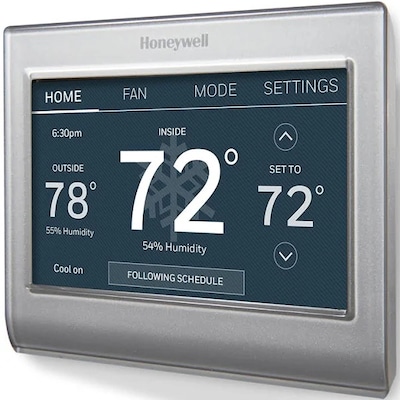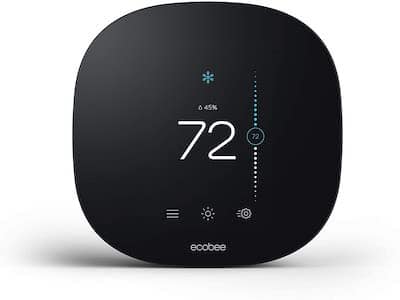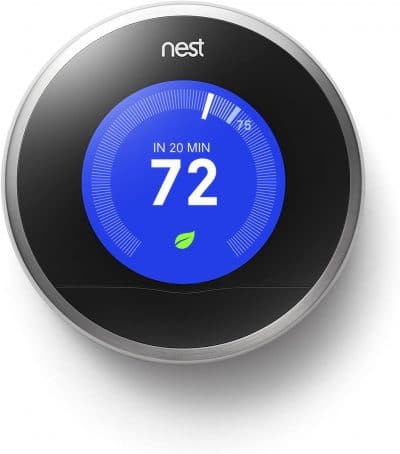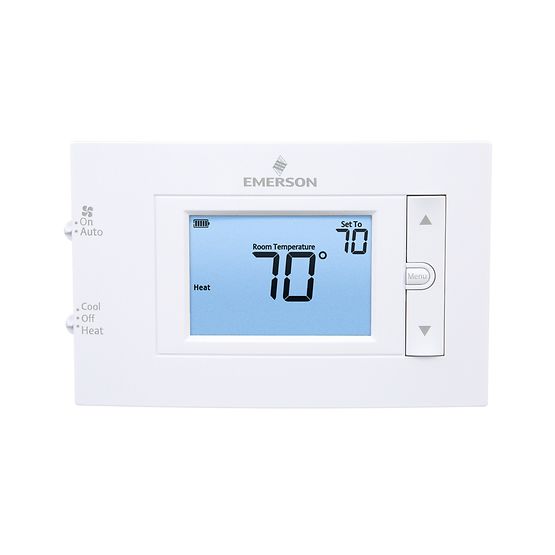What Is the Ideal Temperature To Set the Thermostat?
According to the US Department of Energy, the answer is 68°F (winter) or 78°F (summer) when you are home and awake. You can lower the temperature while asleep regardless of the season because studies show we get better, sounder sleep in a cooler environment as our body temperature lowers during this time. Likewise, you can adjust your thermostat for the times when you are away so that your HVAC system will not kick on as often to heat or cool your home.

Table of Contents
- Types of Thermostats to Consider
- Thermostat Installation Tips
- How to Set Your Thermostat for Efficiency
- Helpful Tips for Thermostat Use
- Popular Questions About Thermostats
- Manual Thermostat – You are the brains of the operation and have to change the temperature settings yourself.
- Programmable Thermostat – Most work based on the same options: Wake Time, Sleep Time, Leave Time, and Return Time. There are a few programming options, depending on the brand and model you choose, including: 7-day, 5-1-1, 5-2, and 1-week programming. These are not generally recommended for heat pumps.
- Smart Thermostat – These help your home’s HVAC system operate at maximum efficiency by giving you data about your energy usage, how to could reduce it, and how it compares to prior usage. These can be programmed or will automatically adjust according to your daily habits. You can even control lights, locks, and other appliances with smart assistants, e.g. thermostats that work with Alexa.
- Wi-Fi Thermostat – These have sensors that communicate with an app on your phone and can notify you when the temperature in your home deviates from specified settings. Some can gauge the temperature and humidity outside, so you can adjust your settings accordingly. Power outages and downed Wi-Fi can be problematic for remotely controlling your home’s temperature.
- Direct sunlight
- Lighting
- Appliances
- Drafts
- Registers
- Doorways
- Fireplaces
- Skylights and windows
- Furniture in front of or below it
- Honeywell thermostat
- Nest thermostat
- American Standard thermostat
- Lennox thermostat
- Ecobee thermostat
- White Rogers thermostat
- Emerson thermostat
- Sensi thermostat
- Trane thermostat
- Braeburn thermostat
- Observe how quickly your home cools off, how well it is insulated, and what the humidity level is — this info will help you find the right temperature.
- Test and Identify the ideal temperature for your home – Conduct a Thermostat test by starting at 72 degrees (during the summer), then every day increasing the temperature by one degree. The day someone (or multiple people) complain about it being too hot, set the thermostat back one degree where no one complained: You just found the sweet spot of comfort for the whole house without them even knowing you were experimenting!
- Home: 78 degrees Fahrenheit
- Asleep*: 67 degrees Fahrenheit
- Away: 85 degrees Fahrenheit
- Home: 68-70 degrees Fahrenheit
- Asleep*: 65 degrees Fahrenheit
- Away: 65 degrees Fahrenheit
- Adjust thermostat in 5-8 degree increments.
- You can temporarily override your set schedule whenever you want until you are ready to resume it without losing your established programming.
- Your HVAC system will cool/heat your home at the same pace at the energy-efficient temperature you set it at as it would if you cranked it to an extreme. Doing the latter just takes more energy and, therefore, costs more.
- Install name-brand batteries; they last longer, and you can change them annually.
- A ceiling fan can make a room feel up to four degrees cooler. Make sure it spins counterclockwise in the summer. This creates a downdraft and adds a cool breeze to your space. Then return it clockwise in the winter to create an updraft for warm air circulation.
- Use a humidifier (winter) or dehumidifier (summer) to supplement your HVAC system in regulating the temperature and your comfort.
- Hang window treatments to block light and heat/cold leaking through the windows.
- Seal windows and doors with weather strips and/or caulk.
- Use the oven during the coolest parts of the day.
- Replace HVAC system(s) with the most energy-efficient models.
- Thermostat Replacement Services in Nashville, TN
- Thermostat Replacement Services in St Louis, MO
- How to Control Humidity in the Home
- How to Improve Tap Water Quality
- Carbon Monoxide in Home – Find Solutions
- How to Unclog a Sink, Bathtub or Shower
- Electrical Outlets Safety Checklist
- Eliminating a Sewer Smell in Bathroom and Throughout the House
- How Often To Clean Air Ducts
- Environmental Impacts of Geothermal Energy and HVAC
- Replace a Stab Lok Breaker in your Federal Pacific Electrical Panel
Types of Thermostats

The thermostat allows you to control the comfort and temperature as well as the humidification, dehumidification, and ventilation of your home. It may even determine the type of HVAC equipment you choose.
There are four types of thermostats, and choosing the right one for your home is very important:
Consider This for Thermostat Installation
While thermostat installation can be a DIY project, it really is a job best left to a licensed electrician. Always put electrical safety first. Call an experienced pro that knows how to install a thermostat without running into electrical issues.
Best Place to Install a Thermostat

Otherwise, you run the risk of getting “ghost readings” or inaccurate readings of the temperature of your home that cause your heating and cooling system to cycle unnecessarily.
Thermostat Compatibility, Incentives, and Brands

Make sure the thermostat is compatible with your HVAC system. Take into consideration that some cities and states give tax breaks, incentives, and rebates for installing energy-efficient thermostats. Empowered with this info, search through popular brands such as these to find the right fit for your home:
How to Set Thermostat for Maximum Efficiency

According to the US Department of Energy, using a programmable thermostat allows you to establish a pre-set schedule that can “repeat multiple daily settings (six or more temperature settings a day) that you can manually override without affecting the rest of the daily or weekly program.” Doing so “can save as much as 10 percent a year on heating and cooling by simply turning your thermostat back 7°-10°F for 8 hours a day from its normal setting.”
Why keep your house at one or two temperature settings (home and asleep, both optimized for your comfort) when for a large portion of your day or week, you may not even be home? Setting the temperature back for the times you are out of the house can actually save you money.
Adjust Your Temperature for Your Lifestyle
Knowing your home and those who share it with you are two other important factors in setting yourself up for thermostat success.
Keep these considerations in mind:
Bonus benefit: According to ENERGY STAR, even that one-degree difference could produce a one percent savings on your utility bill.
Ideal Temperatures by Season
Of course, the optimal temperature is going to depend on the current season and the region where you live. However, there are a few rules of thumb to live by:
Summer Temperatures
Winter Temperatures
*Sleep.org reports bedroom temps should be 60–67 degrees Fahrenheit for optimal sleep.
Other Helpful Tips for Thermostat Use
FAQ’s About HVAC Thermostat Use
The “hold” button is used to set your thermostat at a constant energy-saving temperature. This is a great feature to use when you go on vacation or take a weekend road trip.
Beyond convenience, there are no direct benefits of keeping your thermostat at the same temperature since most thermometers will trigger your system to turn on or shut off throughout the day. There is an energy-saving benefit of setting your auto thermostat settings slightly warmer in summer for AC and slightly cooler in winter for heating.
With several systems, there is a possibility of overriding the thermostat and getting your heating and cooling system to run according to your manufacturer’s instructions. In general, however, HVAC systems must have a temperature command set from a working and charged thermometer in order to function correctly.
Generally, the batteries for your thermostat should last about one year. It’s a good idea to set an alert on your calendar to replace them annually.



